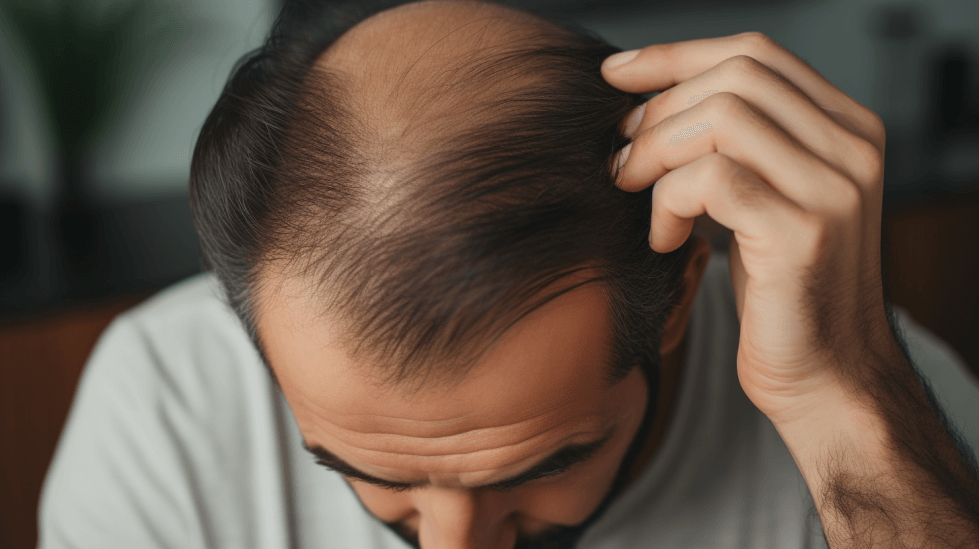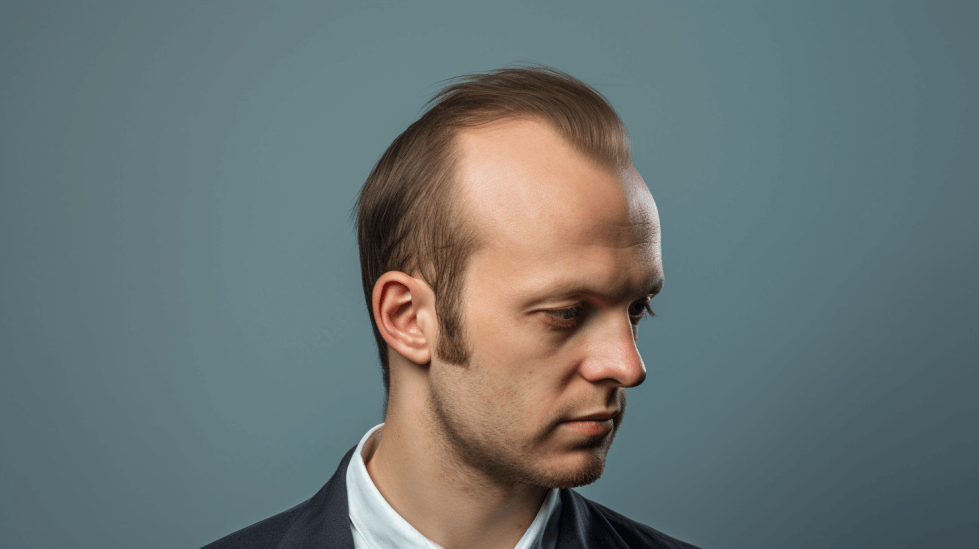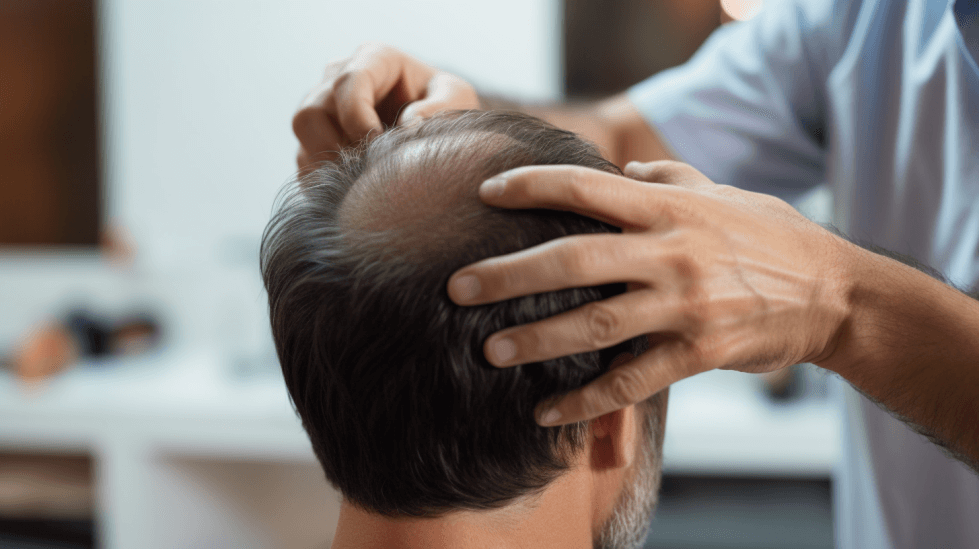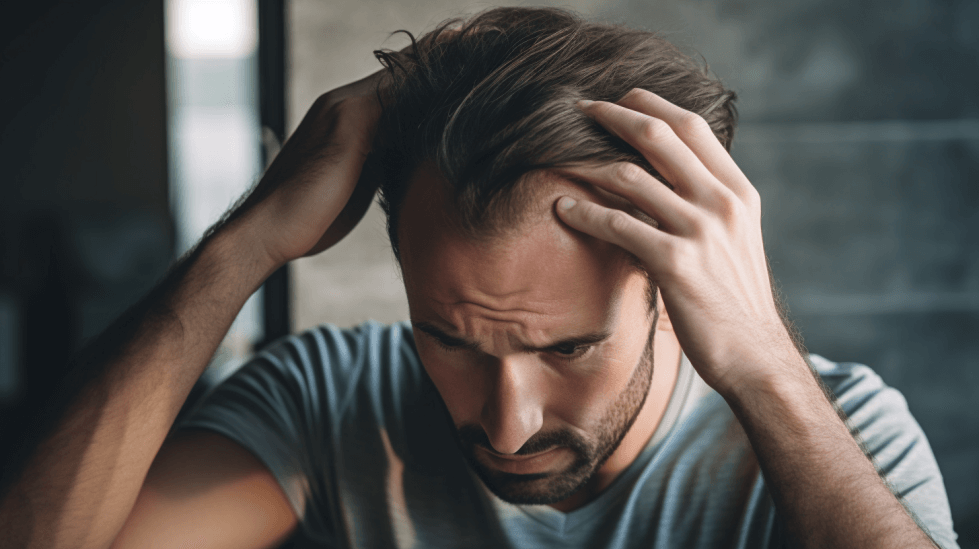What Causes Men’s Hair Loss
As we get older, it’s not uncommon for men to experience hair loss. Many factors contribute to this process, including genetics, hormonal changes, and environmental factors. It’s essential to understand what causes men’s hair loss in order to effectively address the issue and maintain healthy hair growth.
In my research, I’ve found that the primary cause of hair loss in men is androgenetic alopecia, also known as male pattern baldness, which is responsible for 95% of hair loss cases. This hereditary condition often results in a receding hairline and thinning hair on the top of the head. It occurs due to a sensitivity to dihydrotestosterone (DHT), a hormone that affects hair follicles, causing them to shrink and eventually stop producing hair altogether.
Other causes of hair loss in men can be medical issues, stress or shock, infections, and immune system problems. These factors might lead to temporary or permanent hair loss, depending on the underlying cause and its severity. Acknowledging these various causes can help in determining the appropriate approach to treating and preventing further hair loss.

Causes of Men’s Hair Loss
As I explore the various factors responsible for men’s hair loss, it becomes apparent that there are several interconnected causes.
Genetic Factors
One of the main causes of hair loss in men is hereditary, with conditions like male pattern baldness, androgenetic alopecia, and androgenic alopecia all contributing to the problem. Often, the first sign of hereditary hair loss is a receding hairline or a bald spot on the top of the head (REX MD).
Hormonal Changes
Hormonal imbalances can also lead to hair loss in men. Testosterone, the essential male hormone, can be converted into dihydrotestosterone (DHT) in the scalp. This hormone has been linked to the reduced ability for healthy hair growth (REX MD).
Medical Conditions
There are numerous medical conditions that can result in hair loss. Some examples include autoimmune disorders that cause patchy hair loss, such as alopecia areata, infections like tinea capitis (a type of fungal infection), or even certain forms of cancer, like prostate cancer (Mayo Clinic). Thyroid problems or conditions like polycystic ovary syndrome can also lead to hormonal imbalances that cause hair loss (WebMD).
Lifestyle and Environmental Factors
Lifestyle choices and environmental factors also contribute to hair loss in men. For instance, exposure to emotional stress, nutritional deficiencies (like iron deficiency), or undergoing a significant weight loss can all impact hair health (Healthline). Temporary hair loss can also be caused by hairstyles that pull on the hair tightly, like certain braids or buns, leading to traction alopecia (WebMD).
To summarize, the causes of men’s hair loss are diverse and often intertwined. Genetic predisposition, hormonal changes, underlying medical conditions, and lifestyle factors all play a role in affecting a man’s hair health.

Types of Men’s Hair Loss
During my research on men’s hair loss, I came across several types that affect men in various ways. Among them, the most common type of hair loss is male-pattern baldness, also known as androgenetic alopecia. This condition is inherited and usually causes a receding hairline, followed by thinning on the top and sides of the head. It is believed to be related to the presence of androgen receptors, which influence hair growth and male hormone levels.
Another type I discovered is alopecia areata, an autoimmune disease that causes hair loss when the body’s immune system attacks the hair follicles. This can result in hair loss not just on the scalp, but anywhere on the body. Though not as prevalent as male-pattern baldness, it still affects a significant number of men and can lead to feelings of low self-esteem.
Additionally, there’s telogen effluvium, a temporary form of hair loss that’s often triggered by stress or hormonal changes. During this time, the hair follicles enter a resting phase, leading to hair thinning.
Some other types of hair loss I found include:
- Traction alopecia: Caused by tight hairstyles or excessive tension on the hair shafts, leading to damaged hair follicles and hair loss.
- Anagen effluvium: Hair loss during the active growth phase, often due to medications or treatments such as chemotherapy.
- Scarring alopecia: Hair loss caused by scarring of the scalp, frequently a result of trauma, skin infections, or autoimmune diseases.
By understanding these various types of hair loss, one can better identify the causes and seek appropriate treatment for their specific situation.

Diagnosis and Evaluation
Dermatologists often come across men who are struggling with hair loss. When it comes to diagnosing and evaluating hair loss, finding its cause is crucial. Several factors can cause hair loss, such as medical conditions, medications, or hormonal imbalances. In men, the most common form of hair loss is androgenic alopecia or male-pattern baldness. This condition is hereditary and involves male sex hormones, leading to a receding hairline or bald spots on the crown of the head.
To begin the evaluation process, a Dermatologist performs a thorough examination of the scalp, looking for any signs of inflammation, fungal infection, or autoimmune conditions such as alopecia areata. If necessary, they will conduct blood tests to assess hormone levels, nutrient deficiencies, or any signs of other medical conditions that may be contributing to hair loss.
In some cases, hair loss may be the result of external factors. Wearing tight hairstyles such as braids, using products that may damage hair, or having a poor diet can all contribute to hair loss. A dermatologist may advise patients to carefully consider their overall hair care routine and make necessary changes to maintain healthy hair.
If the cause of hair loss remains unclear, they may perform further tests, such as a scalp biopsy or microscopic examination of the hair. This information helps determine the most appropriate treatment options for the patient. Early treatment is often more effective, so I encourage those experiencing hair loss to consult a healthcare provider as soon as possible.
Contrary to popular belief, male-pattern baldness is not solely dependent on your mother’s genes. It can be influenced by genetics from both sides of the family, making it crucial to understand the extent to which family history plays a role in hair loss.
As for treatment options, A dermatologist will discuss various medical and surgical treatments with their patients, such as hair transplantation, oral medications, or topical solutions. Each patient’s needs are unique, and the most effective treatment will vary depending on the individual and their specific type of hair loss. Additionally, some patients find relief through platelet-rich plasma therapy, which uses the patient’s blood to promote hair growth and decrease hair loss.
Remember that hair loss affects millions of men and women, and it’s essential to approach the diagnosis and evaluation process with patience and understanding. Working closely with a dermatologist or healthcare provider can help you find the best way to manage your hair loss and maintain your confidence.

Treatment Options
In my research on hair loss, I have come across a variety of treatment options that aim to resolve the issue for men. These treatments can be categorized into medical treatments, surgical procedures, and alternative treatments. In this section, I will discuss these categories in more detail.
Medical Treatments
There are medications available to target hair loss caused by hereditary conditions, one of the most common being male pattern baldness. Minoxidil (Rogaine) is an FDA-approved treatment that I found to be highly recommended. By applying it to the scalp, it helps stop hair shedding and promotes hair regrowth. Another medication, finasteride (Propecia), is a prescription pill that inhibits the production of the hormone responsible for hair loss, thus promoting hair growth as well.
Surgical Procedures
For those experiencing more significant hair loss, surgical procedures like hair transplant surgery can be an option. There are two popular surgical methods that I have found: follicular unit transplantation (FUT) and follicular unit extraction (FUE). In both procedures, hair follicles are taken from parts of the body with healthy hair growth and transplanted to the top of the head, addressing the areas with thinning hair or complete baldness. Both methods have their advantages and disadvantages, so it’s essential to consult with a specialist to determine the best option.

Alternative Treatments
Besides medical treatments and surgical procedures, there are alternative treatments and lifestyle changes that can potentially help with hair loss. Some of these options include:
- Laser therapy: This method uses red light to stimulate hair follicles, promoting new hair growth.
- Scalp massage: Massaging the scalp can increase blood flow, potentially enhancing hair growth.
- Nutrition: Ensuring a balanced diet that includes essential vitamins and minerals can contribute to overall hair health.
- Reducing stress: Since stress can negatively impact the hair growth cycle, managing stress levels may help minimize hair loss.
It is important to remember that results may vary for different individuals, and consulting with a specialist is crucial to determine the most suitable treatment option.
